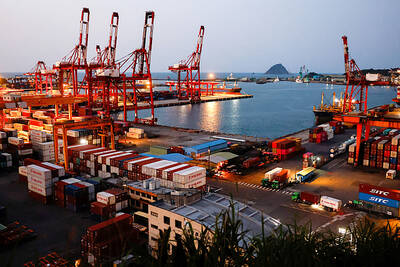The Han Kuang exercises, Taiwan’s largest annual military drills, began yesterday, with experts saying that the extended 14 days of war games were in response to China’s increasing “gray zone” activities and its potential to carry out a full-scale invasion of Taiwan.
This year’s exercises started with around-the-clock computer-aided war games, using the US-built Joint Theater Level Simulation platform.
The live-fire component of the exercises is to be held from July 9 to 18.

Photo: CNA
The drills are to create scenarios in which Chinese People’s Liberation Army (PLA) military exercises escalate into an attack on Taiwan, said Major General Tung Chi-hsing (董冀星), director of the Ministry of National Defense’s joint operations planning division.
The Han Kuang exercises would also simulate PLA “gray zone” activities, which are provocative or aggressive actions that fall just short of an open conflict, Tung told a news conference on Wednesday.
Democratic Progressive Party Legislator Wang Ting-yu (王定宇) on Friday said that the public used to think that a first strike by China would likely come in the form of a missile attack.
However, it is more realistic to think that a first strike would involve maritime militia vessels, sand dredgers and drones, which are commonly used in “gray zone” operations, he said.
Wang, a member of the legislature’s Foreign Affairs and National Defense Committee, said the military has to consider how to deal with situations that go beyond traditional force-on-force confrontations.
These include how to respond to “gray zone” activities within the bounds of international law, while preventing Chinese military drills from escalating into a full-scale invasion, he said.
Such complex scenarios require detailed planning and simulation, making the war games more time-consuming, he said.
Su Tzu-yun (蘇紫雲), director of the Division of Defense Strategy and Resources at the Institute for National Defense and Security Research, expressed similar views, saying that the Han Kuang drills were likely extended this year from eight days to two weeks to facilitate more scenarios involving “gray zone” tactics.
When the PLA is conducting its naval and air patrols around Taiwan, it usually deploys six to 10 warships, Su said, adding that if each of them were equipped with vertical launching systems, there could be about 500 land-attack cruise missiles ready to strike targets across Taiwan within three minutes.
That would leave defense forces with even less response time than if Dongfeng (East Wind, 東風) missiles were launched across the Taiwan Strait from China, he said.
That makes simulating such scenarios critically important, particularly as PLA drills near Taiwan have become more frequent in the past few years, he added.
Minister of National Defense Minister Wellington Koo (顧立雄) in a recent legislative hearing said this year’s Han Kuang exercises would be based on a hypothetical invasion by the PLA in 2027, Su said.
That year would mark several milestones in China, such as the 100th anniversary of the PLA’s founding, the start of Chinese President Xi Jinping’s (習近平) fourth term in office and the 12th year of Xi’s military reforms, he said.
This year’s exercises would test how the Ministry of National Defense would respond in the event of a 2027 invasion and assess any shortcomings in the armed forces’ readiness and arsenal of weapons, Su said.

US President Donald Trump yesterday announced sweeping "reciprocal tariffs" on US trading partners, including a 32 percent tax on goods from Taiwan that is set to take effect on Wednesday. At a Rose Garden event, Trump declared a 10 percent baseline tax on imports from all countries, with the White House saying it would take effect on Saturday. Countries with larger trade surpluses with the US would face higher duties beginning on Wednesday, including Taiwan (32 percent), China (34 percent), Japan (24 percent), South Korea (25 percent), Vietnam (46 percent) and Thailand (36 percent). Canada and Mexico, the two largest US trading

China's military today said it began joint army, navy and rocket force exercises around Taiwan to "serve as a stern warning and powerful deterrent against Taiwanese independence," calling President William Lai (賴清德) a "parasite." The exercises come after Lai called Beijing a "foreign hostile force" last month. More than 10 Chinese military ships approached close to Taiwan's 24 nautical mile (44.4km) contiguous zone this morning and Taiwan sent its own warships to respond, two senior Taiwanese officials said. Taiwan has not yet detected any live fire by the Chinese military so far, one of the officials said. The drills took place after US Secretary

CHIP EXCEPTION: An official said that an exception for Taiwanese semiconductors would have a limited effect, as most are packaged in third nations before being sold The Executive Yuan yesterday decried US President Donald Trump’s 32 percent tariff on Taiwanese goods announced hours earlier as “unfair,” saying it would lodge a representation with Washington. The Cabinet in a statement described the pledged US tariffs, expected to take effect on Wednesday next week, as “deeply unreasonable” and “highly regrettable.” Cabinet spokeswoman Michelle Lee (李慧芝) said that the government would “lodge a solemn representation” with the US Trade Representative and continue negotiating with Washington to “ensure the interests of our nation and industries.” Trump at a news conference in Washington on Wednesday announced a 10 percent baseline tariff on most goods

THUGGISH BEHAVIOR: Encouraging people to report independence supporters is another intimidation tactic that threatens cross-strait peace, the state department said China setting up an online system for reporting “Taiwanese independence” advocates is an “irresponsible and reprehensible” act, a US government spokesperson said on Friday. “China’s call for private individuals to report on alleged ‘persecution or suppression’ by supposed ‘Taiwan independence henchmen and accomplices’ is irresponsible and reprehensible,” an unnamed US Department of State spokesperson told the Central News Agency in an e-mail. The move is part of Beijing’s “intimidation campaign” against Taiwan and its supporters, and is “threatening free speech around the world, destabilizing the Indo-Pacific region, and deliberately eroding the cross-strait status quo,” the spokesperson said. The Chinese Communist Party’s “threats